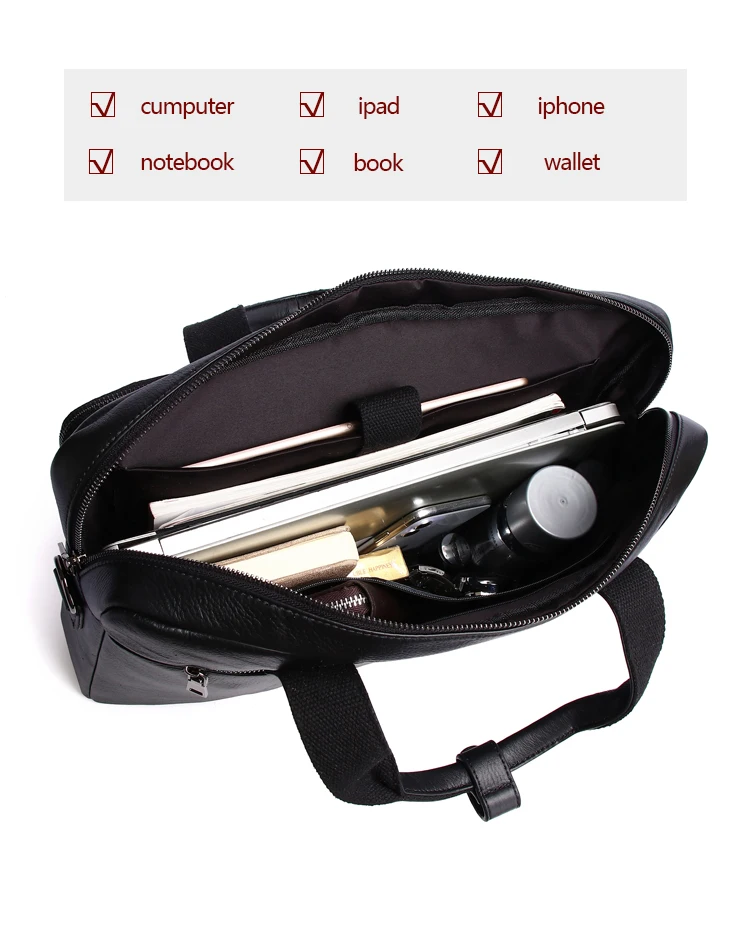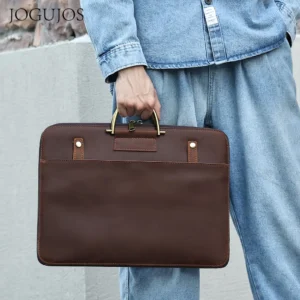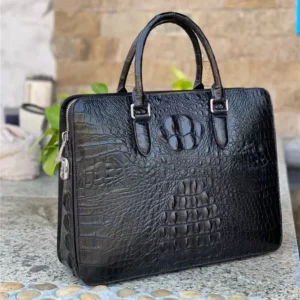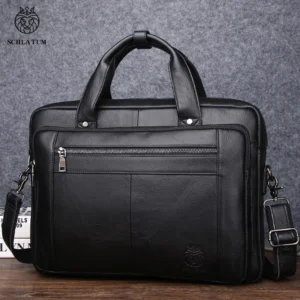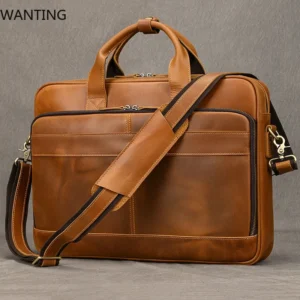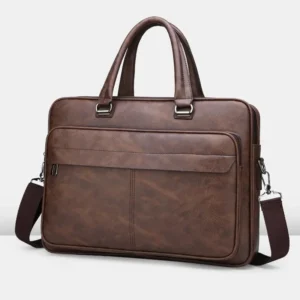When investing in a leather briefcase, durability becomes a primary concern. After all, you want your professional companion to withstand daily use while maintaining its sophisticated appearance. Top-grain leather briefcases offer an excellent balance of refinement and longevity, but understanding what affects their durability can help you make better decisions and extend their lifespan.
What Is Top-Grain Leather and How Is It Made?
Top-grain leather is the second highest quality grade of leather, right after full-grain. It comes from the upper portion of the hide, where the strongest and most durable fibers exist. During manufacturing, the outermost surface is carefully sanded to remove natural imperfections like scars, insect bites, and wrinkles.
This processing results in several key characteristics:
- Smoother, more uniform appearance compared to full-grain leather
- More consistent texture and color absorption
- Thinner and more pliable material (typically 1.2-2.0 mm thick)
- Slightly less breathability due to altered natural pore structure
- Enhanced resistance to staining through applied finishes
The leather undergoes finishing treatments that add protective coatings, creating a surface that resists water and stains better than unfinished leather. While this processing slightly reduces the natural strength compared to full-grain leather, it creates a material that balances professional aesthetics with practical durability.
Top-Grain Leather vs. Other Leather Types for Briefcases
When evaluating durability, it’s helpful to understand how top-grain compares to other leather types commonly used for briefcases:
| Leather Type | Durability | Appearance | Lifespan | Resistance to Wear |
|---|---|---|---|---|
| Full-Grain | Excellent | Natural, develops patina | 15-30+ years | Highest |
| Top-Grain | Very Good | Refined, consistent | 5-15 years | Good |
| Genuine Leather | Fair | Variable | 2-5 years | Limited |
| Bonded Leather | Poor | Artificial uniformity | 1-3 years | Low |
Top-grain leather offers an impressive middle ground. While not as inherently durable as full-grain leather, it significantly outperforms genuine and bonded leathers in longevity tests. The finishing processes actually provide some advantages for briefcases, including better resistance to casual scratching and water spots compared to full-grain leather.
For professional environments, top-grain leather offers a compelling combination of refined appearance and practical durability. The consistent surface makes it ideal for quality briefcases that need to maintain a polished look while enduring regular use.
Expected Lifespan of a Top-Grain Leather Briefcase
A well-crafted top-grain leather briefcase from a reputable manufacturer typically lasts between 5-15 years with proper care. This significant range depends on usage patterns, maintenance habits, and initial quality.
Here’s what you can expect throughout the lifetime of your briefcase:
First Year:
– Subtle softening of the leather
– Minor creasing in high-flex areas (handles, opening)
– Slight darkening in areas frequently touched
3-5 Years:
– Development of a unique patina
– Visible character in high-touch areas
– Softened edges and corners
– Possible hardware wear (zippers, clasps)
5-10 Years:
– Deep, rich patina development
– More pronounced creasing and character
– Potential need for minor repairs (stitching reinforcement)
– Hardware may need maintenance or replacement
10+ Years:
– Significant character development
– Possible structural issues requiring professional attention
– Continued aesthetic evolution
It’s important to distinguish between cosmetic aging (which many find desirable) and structural failure. A timeless classic leather briefcase may look different after years of use but should maintain its functional integrity when properly cared for.
Critical Factors That Determine Top-Grain Leather Durability
Several key factors influence how long your top-grain leather briefcase will last:
Hide Quality and Selection
The original quality of the animal hide dramatically impacts durability. Hides from mature animals with minimal natural flaws create stronger leather, even after the top-grain processing.
Tanning Method
Vegetable-tanned leather tends to develop a beautiful patina and maintains structural integrity longer but is more susceptible to water damage. Chrome-tanned leather offers better water resistance but may not age with the same character.
Thickness and Cut
Ideal briefcase leather typically measures between 1.4-1.8 mm thick—substantial enough for structure without excessive weight. Thicker isn’t always better; the optimal thickness balances durability with flexibility.
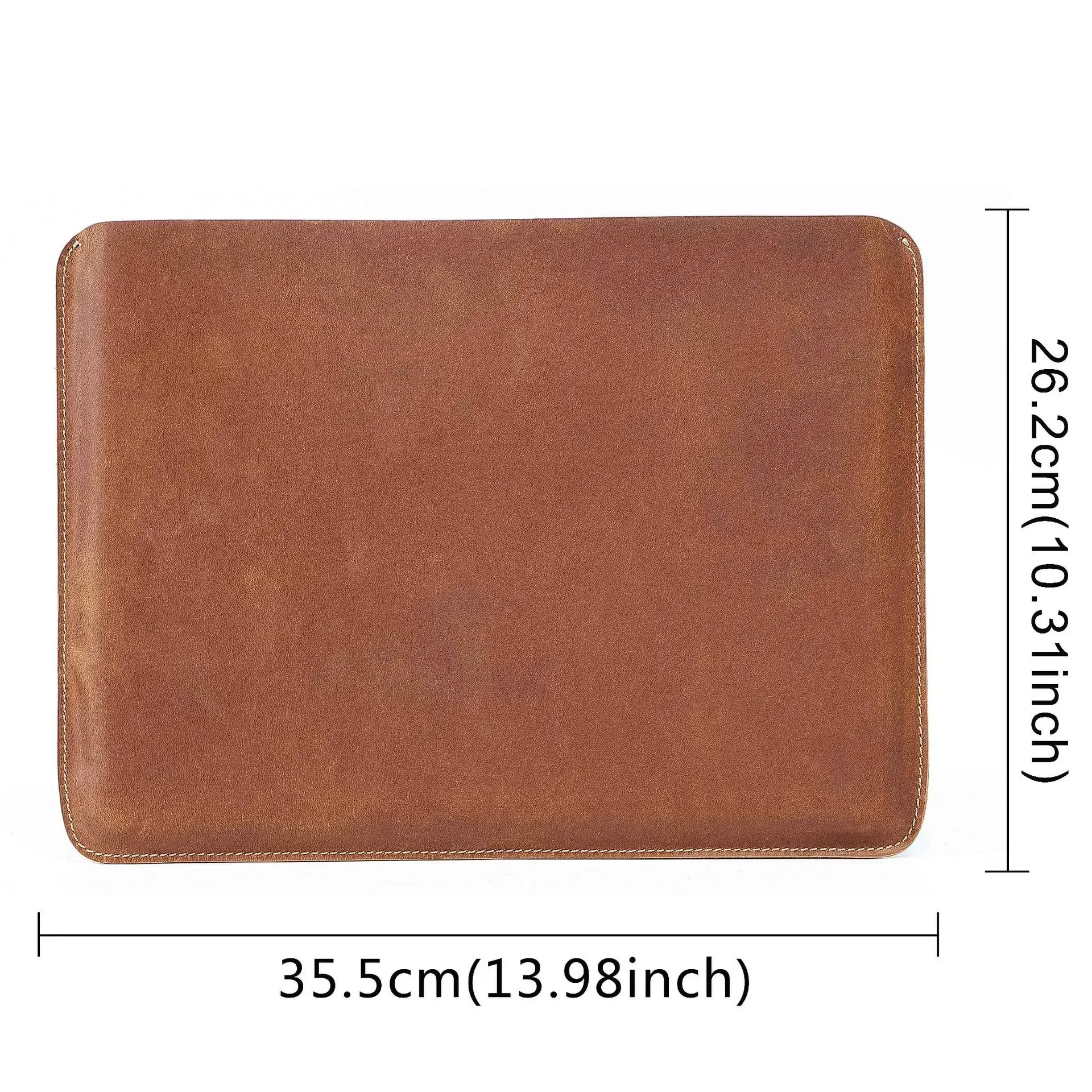
Finishing Treatments
Quality finishing protects the leather from moisture and staining. However, over-finishing can create a plastic-like surface that cracks rather than flexes over time.
Construction Elements
The durability of your briefcase depends significantly on:
– Stitching quality (5-7 stitches per inch is ideal)
– Hardware durability (solid brass or steel outlasts zinc alloys)
– Stress point reinforcement (corners, handles, and straps)
Internal Structure
Often overlooked, the internal construction greatly affects longevity:
– Quality lining prevents stretching and deformation
– Internal reinforcement at stress points
– Edge treatment and sealing techniques
When exploring durable leather briefcase options, these construction elements often differentiate merely good from truly exceptional products.
Common Wear Issues with Top-Grain Leather Briefcases
Even well-made top-grain leather briefcases develop predictable wear patterns over time. Understanding these issues helps you distinguish between normal aging and problematic deterioration.
High-Stress Areas:
– Handle attachment points often show the first signs of wear
– Corners and bottom edges receive constant abrasion
– Closure mechanisms experience repeated stress
Surface Changes:
– Color lightening in areas exposed to sunlight
– Darkening in areas with frequent hand contact
– Minor surface scratches that develop patina
– Possible color transfer from dark leather to light clothing
Structural Concerns:
– Thread deterioration at stress points
– Handle separation or weakening
– Shape distortion from improper storage
– Hardware loosening or tarnishing
Surface Vulnerabilities:
– Water spots from rain exposure
– Scratches from keys or rough surfaces
– Oil absorption from hands
– Dye transfer from wet clothing
Most scratches on leather briefcases can be minimized with proper care, and many actually contribute to the unique character that makes leather goods so desirable with age.
Essential Maintenance for Maximum Durability
Proper care dramatically extends the life of a top-grain leather briefcase:
Regular Cleaning
- Dust with a soft cloth weekly
- Wipe with a slightly damp cloth monthly
- Use leather-specific cleaner quarterly
- Never use household cleaners or harsh chemicals
Conditioning
Apply quality leather conditioner every 3-6 months to:
– Prevent drying and cracking
– Maintain flexibility
– Restore natural moisture balance
– Enhance water resistance
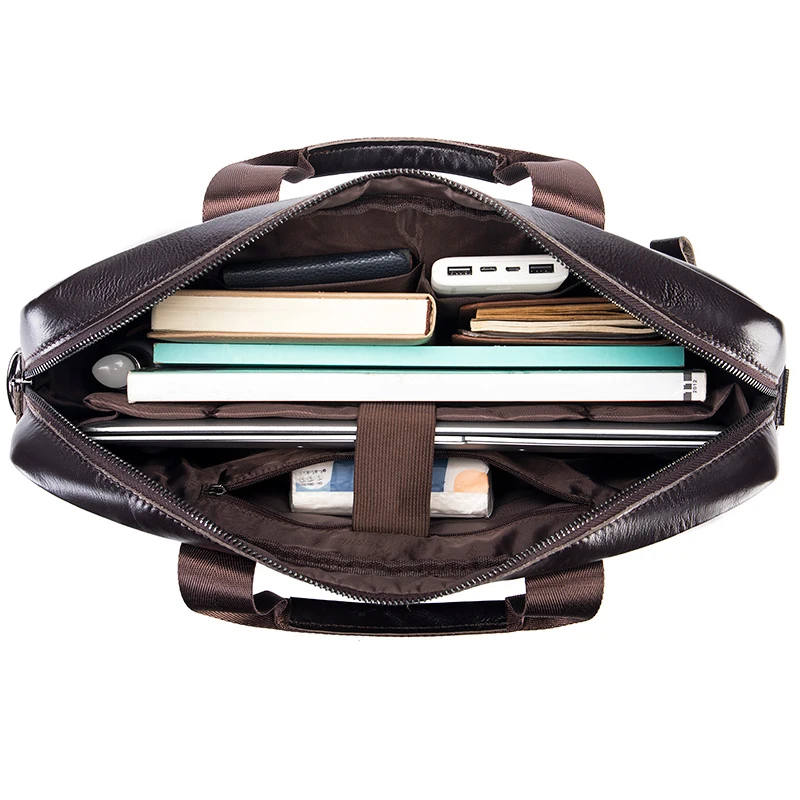
Protective Treatments
- Apply leather protector spray 2-4 times per year
- Focus on high-exposure areas (handles, bottom, edges)
- Test products on an inconspicuous area first
- Choose silicone-free products for breathability
Storage Practices
- Store upright or flat, never hanging
- Use a dust bag when not in use
- Stuff with acid-free paper to maintain shape
- Keep away from direct sunlight and heat sources
Handling Best Practices
- Handle with clean hands
- Avoid contact with cosmetics, lotions, and oils
- Don’t overload the briefcase beyond capacity
- Rotate use if you own multiple bags
Implementing a comprehensive leather briefcase maintenance routine significantly increases your briefcase’s functional lifespan and keeps it looking professional for years.
Quality Indicators: How to Identify a Durable Top-Grain Leather Briefcase
When shopping for a top-grain leather briefcase built to last, look for these quality markers:
Leather Quality Signs:
– Even coloration with subtle natural variations
– Supple feel that’s neither too stiff nor too soft
– Pleasant natural leather smell (not strong chemical odors)
– Visible pore structure despite the finishing process
Construction Excellence:
– Edge finishing: burnished, painted, or folded edges without fraying
– Stitching: tight, even stitches with no loose threads
– Hardware: substantial weight, smooth operation, secure attachment
– Lining: firmly attached, quality material without wrinkles or bubbles
Red Flags to Avoid:
– Plastic-like finish that feels artificial
– Visible glue at seams or edges
– Uneven stitching or loose threads
– Flimsy or lightweight feel
– Strong chemical odor
Ask retailers specific questions about leather sourcing, tanning methods, and construction techniques. Quality manufacturers will gladly provide these details. When comparing options for your ideal leather briefcase, these quality indicators will guide you toward the most durable choice.
How Usage Patterns Impact the Lifespan of Top-Grain Leather Briefcases
The way you use your briefcase significantly affects how long it lasts:
Daily vs. Occasional Use:
A briefcase used daily will naturally show wear faster than one used only for special meetings. Consider rotating between two briefcases to extend the life of both.
Weight Capacity:
Consistently overloading a briefcase strains stitching, handles, and structure. Most professional briefcases are designed for a laptop, documents, and a few essentials—not as substitute luggage.
Environmental Factors:
– Humid environments can promote mildew growth
– Extremely dry conditions cause leather to crack
– Sun exposure leads to fading and drying
– Temperature fluctuations stress leather fibers
Commuting Method:
– Car commuters: Less overall wear than public transit users
– Public transit: More bumping, crowding, and potential scuffing
– Bicycle commuters: Increased exposure to elements and movement
– Air travelers: Compression in overhead bins and handling stress
Proper storage of leather bags between uses can counteract many environmental stressors and extend your briefcase’s life regardless of usage patterns.
Is a Top-Grain Leather Briefcase Worth the Investment?
When considering the price premium of a top-grain leather briefcase, evaluate these factors:
Pros:
– Exceptional durability compared to synthetic materials
– Ages gracefully, often looking better with time
– Professional appearance that synthetic materials rarely match
– Can last 5-15 years with proper care
– Maintains resale value better than lower-quality alternatives
Cons:
– Higher initial investment
– Requires regular maintenance
– Can be heavier than synthetic alternatives
– Susceptible to water damage without proper protection
– Environmental concerns about leather production (though quality leather goods last longer)
From a cost-per-use perspective, a $300-500 top-grain leather briefcase used daily for five years costs approximately $0.30 per day. Compare this to replacing a $100 synthetic bag every year, which costs about $0.27 per day but with constant replacement hassle and declining appearance.
The value proposition becomes even stronger when considering the professional impression created by a quality leather briefcase. For those seeking reliable, professional accessories, the classic leather briefcase collection offers options that balance aesthetics with long-term durability.
Men's Classic Leather Briefcase, Slim Leather Laptop Briefcase, Slim Leather Portfolio Briefcase
$93.67 Select options This product has multiple variants. The options may be chosen on the product pageClassic Laptop Briefcase, Men's Classic Leather Briefcase, Slim Leather Attache Case
Price range: $353.50 through $360.81 Select options This product has multiple variants. The options may be chosen on the product pageBlack Leather Briefcase, Leather Document Bag, Men's Classic Leather Briefcase
Genuine Crocodile Leather Executive Briefcase with Password Lock – Premium Business Document Carrier$1,201.87 Select options This product has multiple variants. The options may be chosen on the product pageBlack Leather Briefcase, Classic Laptop Briefcase, Men's Classic Leather Briefcase, Slim Leather Laptop Briefcase
$228.72 Select options This product has multiple variants. The options may be chosen on the product pageBrown Leather Briefcase, Classic Laptop Briefcase, Crazy Horse Leather Satchel, Men's Classic Leather Briefcase
Price range: $172.15 through $200.02 Select options This product has multiple variants. The options may be chosen on the product pageMen's Slim Leather Briefcase, Slim Leather Laptop Briefcase, Vegan Leather Briefcase
Price range: $120.82 through $131.11 Select options This product has multiple variants. The options may be chosen on the product page
Top-Grain Leather Briefcase Repair and Restoration
One advantage of quality leather goods is their repairability—many issues can be fixed rather than requiring replacement.
Repairable Issues:
– Loose stitching or seams
– Worn edges or corners
– Minor scratches and scuffs
– Hardware replacement (zippers, clasps)
– Handle reinforcement
– Lining repairs
Challenging or Permanent Damage:
– Deep cuts or tears in the leather
– Severe water damage or mold
– Chemical damage or staining
– Structural breakage
– Significant color loss
DIY Repair Options:
– Edge coating restoration for worn edges
– Leather conditioner for minor scratches
– Replacement of basic hardware (screws, feet)
– Simple stitching reinforcement
When to Seek Professional Help:
– Structural issues affecting usability
– Handle reattachment or reinforcement
– Significant water damage restoration
– Color restoration or dyeing
– Lining replacement
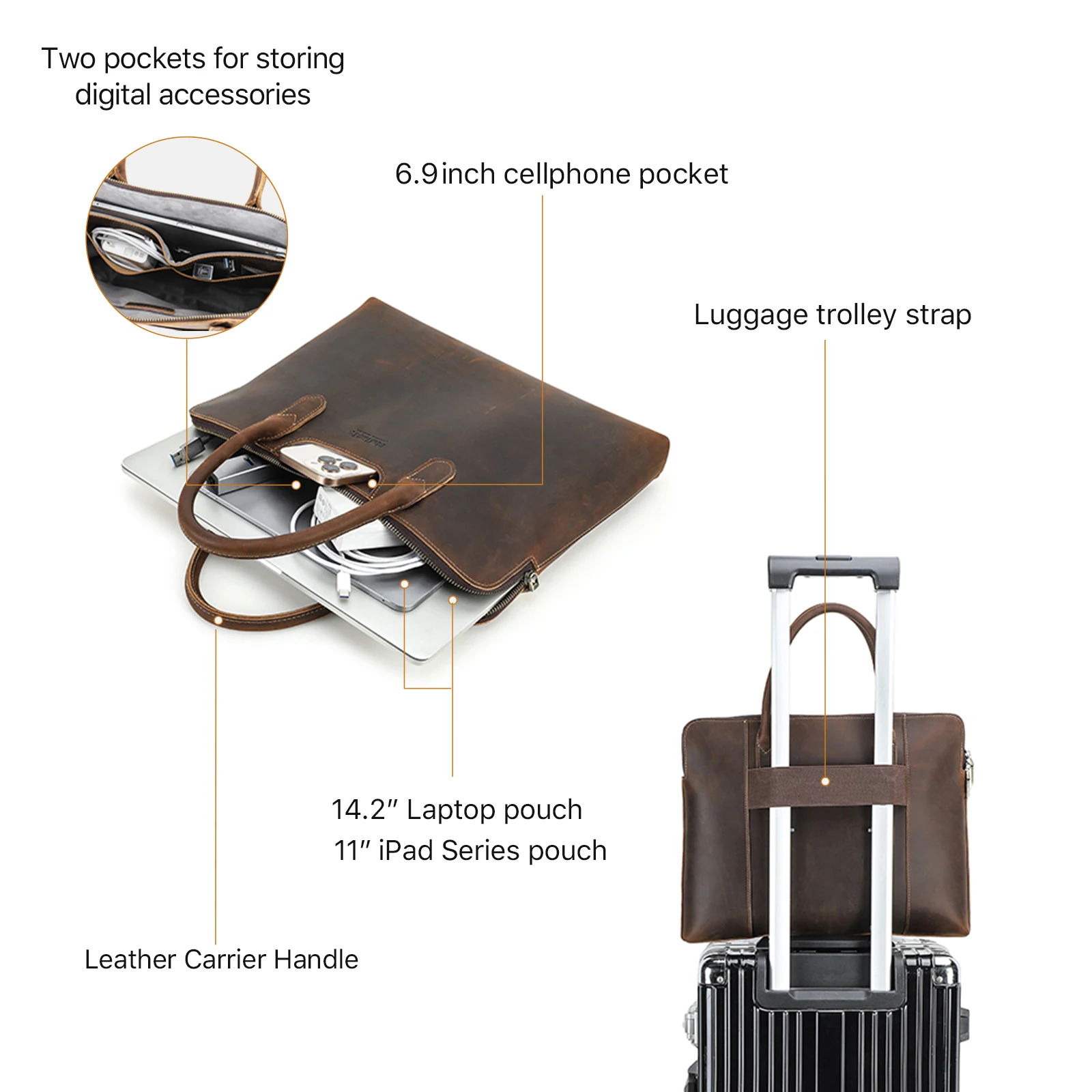
Professional restoration typically costs between $50-200 depending on the extent of repairs, substantially less than replacing a quality briefcase. For ongoing protection of your investment, explore classic leather briefcases designed with repairability in mind.
Common Questions About Top-Grain Leather Briefcase Durability
Can top-grain leather briefcases be used in the rain?
While brief exposure to light rain is generally okay, repeated or heavy exposure can damage the leather over time. Apply leather protector regularly and always dry the briefcase thoroughly if it gets wet.
Is top-grain leather prone to scratching?
Top-grain leather is more scratch-resistant than full-grain leather due to its processing and finishing. Minor scratches can often be buffed out with a soft cloth or minimized with leather conditioner.
How does top-grain leather age visually?
It develops a more subtle patina than full-grain leather. The surface remains relatively consistent but gains character in high-touch areas like handles and edges, often darkening slightly over time.
Will my top-grain leather briefcase transfer color to my clothing?
Quality top-grain leather with proper finishing should have minimal color transfer. However, excessive moisture or new, darkly colored leather may occasionally transfer to light clothing.
How much weight can a top-grain leather briefcase typically hold?
Most well-made briefcases can safely carry 10-15 pounds, though consistently carrying maximum weight will accelerate wear on handles and stress points.
Does top-grain leather maintain its shape over time?
With proper storage and reasonable use, top-grain leather briefcases maintain their shape well. Using internal organizers or stuffing with paper when stored helps preserve the original form.
For professionals needing to carry technology safely, laptop-friendly briefcases offer specialized compartments while maintaining the durability benefits of top-grain leather. Similarly, for those preferring a contemporary profile, slim leather laptop briefcases provide durability in a streamlined design. Alternatively, professional messenger bags offer a more casual but equally durable option for daily commuting.

